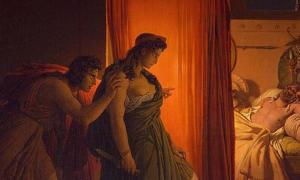
Clytemnestra: A mother's revenge
Queen Leda, wife of King Tyndareus, hatched out the most remarkable set of quadruplets the world had ever seen. It is little wonder that she would have done so, as their conception was, itself, extraordinary. Within the span of a single night, Leda lay with her devoted husband and then also with Zeus who seduced her while assuming the form of a beautiful white swan. Despite her mammalian ancestry, Leda produced two pearl white eggs, one for each coupling. From the egg she conceived with Zeus emerged the girl who would become Helen of Troy and Polydeuces, also known as Pollux. Emerging from the other egg- the one that Tyndareus fertilized- was Castor and his twin sister Clytemnestra. Three of these children are quite well known. Helen's abduction precipitated the Trojan War. Castor and Polydeuces would go on to become the Dioscuri, immortalized in the night sky as the "Gemini Twins." Clytemnestra, the fourth quadruplet, never achieved the same fame her siblings enjoyed. Her relative obscurity is rather surprising for hers was a deeply tragic, and therefore quite compelling, story.
When King Tyndareus selected Menelaus to wed his stepdaughter Helen, he chose Menelaus' brother Agamemnon to marry Clytemnestra. Although the arrangement was not of her choosing, Clytemnestra's marriage was initially quite happy. She and Agamemnon sired three daughters: Iphigenia, Electra and Chrysothemis and one son Orestes. When the Trojan prince Paris abducted Helen, Agamemnon and many other men who had also once sought Helen's hand in marriage were obligated to sail to Troy to regain her. The hundred-ship armada Agamemnon assembled at first could not depart due to fierce contrary winds. The gales persisted for so long Agamemnon consulted the prophet Calchas for guidance. Calchas informed him that the moon goddess Artemis had conjured the tempests in order to detain Agamemnon's vessels. Just before Helen's abduction, Agamemnon had slain a hare in a grove sacred to Artemis. She summoned the winds as a punishment. Calchas regarded Agamemnon gravely. "Only by sacrificing your eldest daughter will the goddess be appeased and winds abate." Agamemnon immediately sent a messenger back to his home to inform Iphigenia that she was to be wedded to Achilles, Greece's bravest warrior, at once. Knowing that his daughter had long been smitten with Achilles, he expected her to arrive quickly, which she did. Without a word, Agamemnon unsheathed his sword and ran her through. The winds then ceased, permitting the ships to depart. Agamemnon was abjectly miserable, for not only did he just slay his eldest daughter, but he did not know how he would be able to explain what had transpired to his wife when he returned from Troy. He needn't have worried. Clytemnestra had followed her daughter most of the way down to the dock and then concealed herself so as to secretly witness the marriage. When she saw her husband slay Iphigenia, she fainted with terror. By the time she awoke, Agamemnon's armada had left. From that moment Clytemnestra's love for her husband died.
During the ten years that elapsed between Agamemnon's departure and his triumphant return, Clytemnestra took her husband's estranged cousin, Aegisthus, as a lover. They conspired to avenge her daughter's death on her father's return. (It would have been pointless to have traveled to Troy where Agamemnon was surrounded by protectors.) When he did return, he was in the company of his mistress Cassandra, the prophetess whose warnings were destined to always go unheeded. Flaunting his lover before Clytemnestra merely added fresh insult to ancient injury. To Agamemnon's surprise, his wife welcomed him warmly and even behaved graciously toward them both. "Dearest husband, I know what happened and what act you were forced to commit by divine decree. Be at peace, my dear, for Iphigenia would want you to be. You and your friend should prepare for dinner. Be hasty for all the children, save Iphigenia, are hungry."
As Agamemnon was about to enter the bathing area, Cassandra whispered to him. "My love, I am terribly frightened. Both of us will die before the Sun sets." He laughed softly and assured her that all was well. "Be content and quiet," he told her. "I shall soon return from the bath I so sorely need." Only a few moments after Agamemnon submerged himself, Clytemnestra and Aegisthus, who had been hiding in a nearby room, rushed toward him. While Clytemnestra ensnared him in his robe, Aegisthus pushed him under water and stabbed him to death. Having heard Agamemnon's cries, Cassandra rushed to his aid. Clytemnestra grabbed Aegisthus' short sword and beheaded her. (In some versions, they slayed Agamemnon and Cassandra as they napped before dinner.)
Electra, the second child, heard what was happening and immediately conducted Orestes out of the house. "Mother has gone mad!" she exclaimed. "She and Aegisthus have killed Father. Go at once to Phocis to the home of father's brother-in-law King Strophius. Do not leave for anything until you are old enough to help me avenge father's murder." Eight years passed until Orestes, then a grown man, resolved to rejoin his sister. First, he consulted the Delphic Oracle, for he knew that shedding kindred blood was the gravest of all mortal transgressions. Apollo assured him that he could avenge his father's murder without fear of retribution for he would be protected by Hera, the powerful goddess of marriage. Orestes arrived at his home and found Electra out in the garden. He brought two daggers, one of which he gave to his sister. They then ran into the house and confronted Clytemnestra and Aegisthus. Orestes engaged Aegisthus in battle while Electra struck down her defenseless mother. Electra then assisted Orestes to disarm and then slay Aegisthus with multiple dagger strikes. Despite Apollo's assurances, Orestes and Electra were pursued by Clytemnestra's furies, the ferocious female spirits that avenge the slaughter of relations. Orestes and Electra fled from their home with the furies in inexorable pursuit. The furies drove them both mad. In their delirious state, they almost slew one another before Apollo, himself, intervened. He thwarted the furies by agreeing to place Orestes and Electra on trial for the double murder. King Tyndareus was selected to adjudicate the matter. Though initially inclined to condemn both his grandchildren for his daughter's murder, he was persuaded by Menelaus to commute the sentence to a single year's banishment. After this banishment Orestes was betrothed to Hermione, the eldest daughter of Helen and Menelaus. About Electra little else is known. Whereas modern psychology recognizes the "Oedipus Complex" in males: the latent desire to kill the father and wed the mother, they have also identified the "Electra Complex," a desire in girls to kill their mothers and wed their father. However, one could argue that this condition is improperly named because Electra never married her father. With the aid of her brother, she merely avenged his death.
THE SOUTHWORTH PLANETARIUM
207-780-4249 www.usm.maine.edu/planet
70 Falmouth Street Portland, Maine 04103
43.6667° N 70.2667° W
Altitude: 10 feet below sea level
Founded January 1970
Julian Date: 2458980.16
Julian Date: 2458980.16
2019-2020: CXLIV
THE DAILY ASTRONOMER
Monday, May 11, 2020
Remote Planetarium 31: A Sun's Life - The Sun's Birth
Last week we learned how astronomers determined the sun's distance, size, mass and chemical composition. To humanity's collective astonishment, they learned that our parent star is approximately 93 million miles away, more than one million times larger and 330,000 times more massive than Earth and consists primarily of hydrogen and helium. Today, we learn the details of the Sun's extraordinary birth approximately five billion years ago.
The details begin with a structure similar to the one seen below:
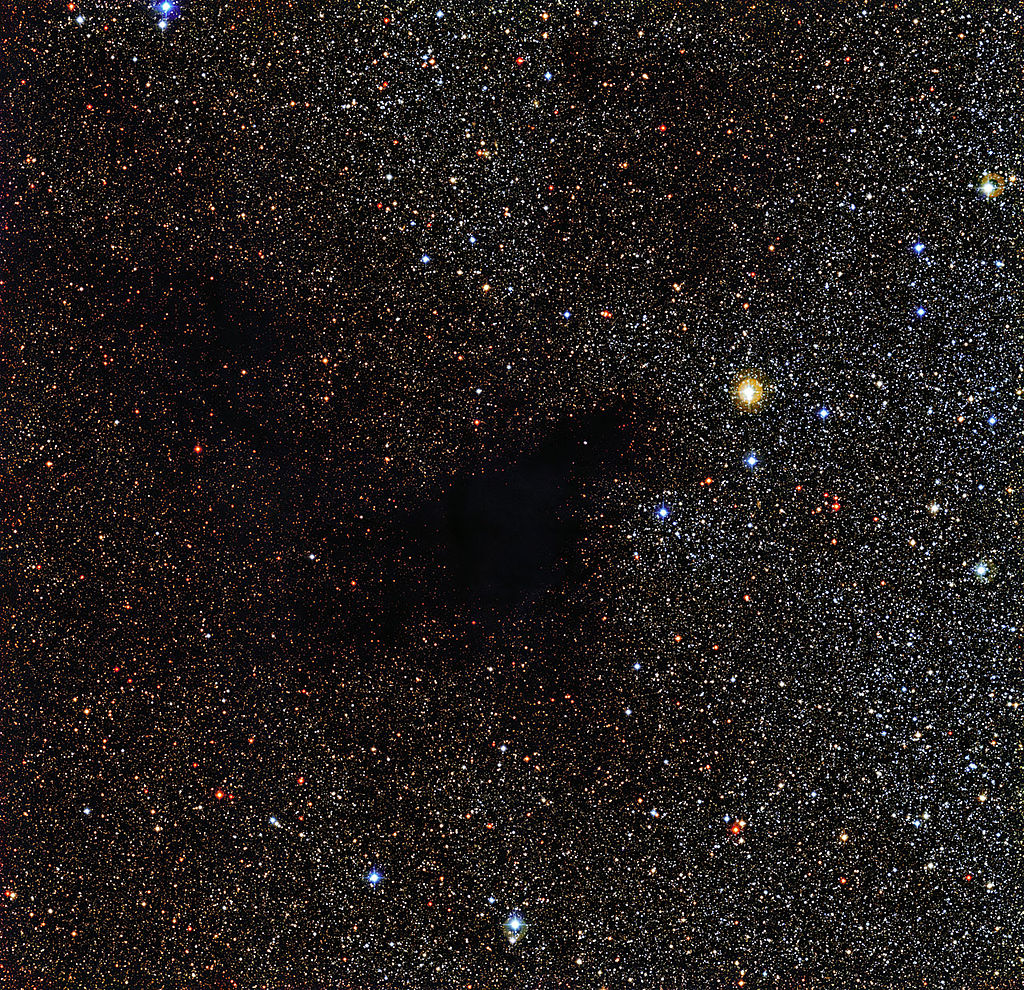
We're seeing the dark nebula LDN 483 located approximately 700 light years from Earth within the constellation Serpens. This irregularly shaped cloud appears silhouette like against the stellar backdrop. Likely numbering in the millions, such dark nebulae are scattered throughout the Milky Way Galaxy. Approximately five billion years ago a dark nebula traveled through the galactic star streams. This cold nebula was devoid of any motion save for the weak eddies and currents that one tends to find within such otherwise inert agglomerations of gas.
Then, within this primordial nebula's "vicinity," the following event occurred:
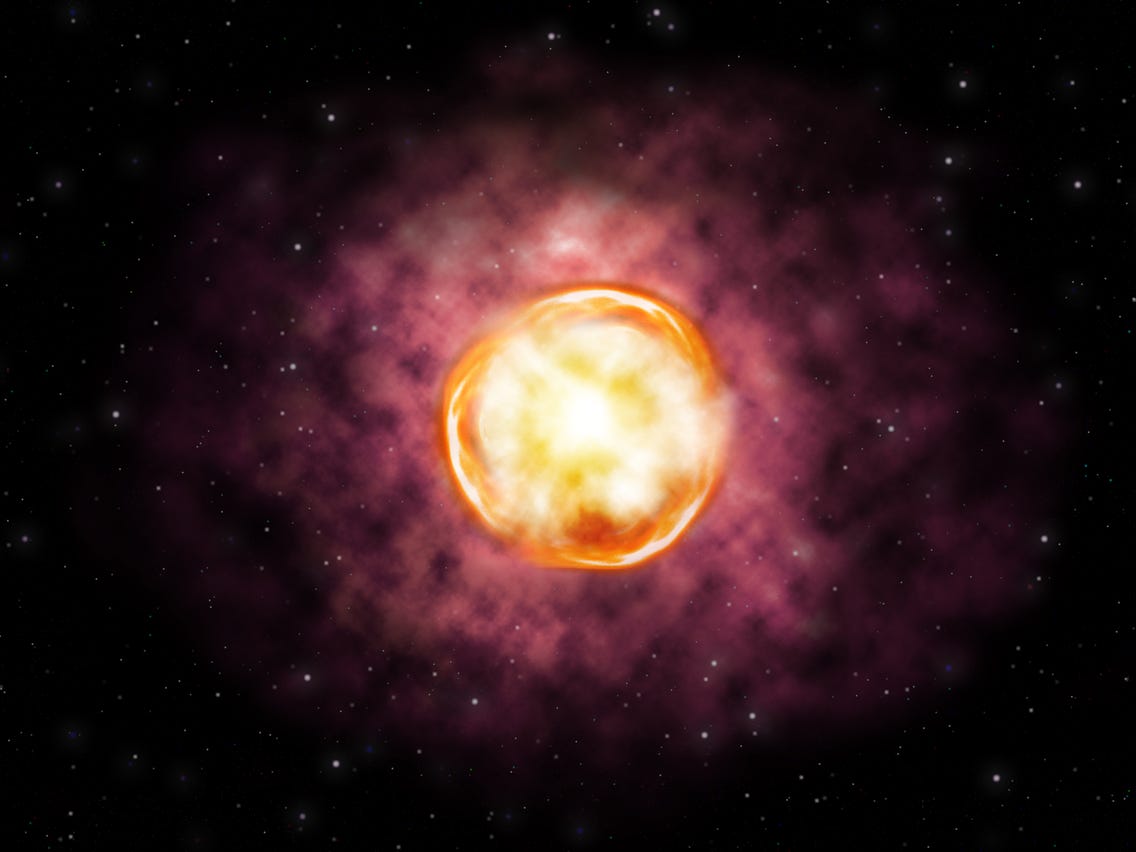
We call this cataclysmic event a "Type II supernova." Later on in this course we will discuss these supernovae in greater detail. For now, suffice it to say that such supernovae occur when a highly massive star explodes from the inside out. This ancient supernova scattered heavy elements radially throughout its intergalactic environment. A small part of that debris field plowed into the dark nebula, chemically enriching the gases while precipitating a slow but inexorable collapse. Were we to witness the collapse, we would find ourselves becoming extremely bored. At first the nebula would exhibit only the subtlest shifting: like the passage of distant shadows along a dark moor. The heated supernova remnants would glow, of course, until cooled through their dispersal. Eventually, the nebula would develop "micro pools," regions within itself that start to become measurably more dense than their surroundings. Although we would still see little, the nebula will become more turbulent. The dense pockets gather more of the surrounding material making them more massive and gravitationally attractive. Akin to a snowball rolling downhill that enlarges its surface area during its descent and therefore constantly increases its capacity for accumulating more snow, the pockets quickly gather an abundance of material.
While we wait for the gas gathering to continue, we need to introduce two protons:
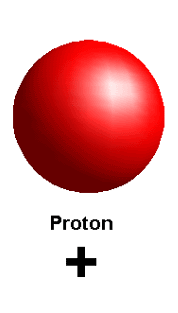
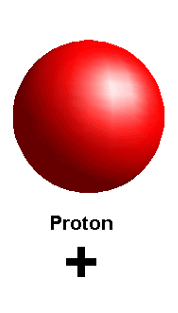
Please meet Heathcliff and Catherine: two simple positively charged subatomic particles that just happen to be part of the bustling maelstrom of hydrogen and helium atoms within one of these pockets. Yes, the one destined to become our Sun. These two protons are not particularly remarkable. For purposes of illustration we plucked them out of the gas just for a moment. Under ordinary circumstances they experience a mutual repulsion as a consequence of their like charges. Known as the Coulomb barrier, this repellent tendency is a manifestation of electromagnetism, one of the fundamental physical forces. The electromagnetic force causes like charges to repel and unlike charges to attract. You have perhaps noticed that if you bring magnets together, they will snap together if the poles are different but will strongly resist being brought together if their poles are the same. These two protons don't want to have anything to do with one another. It is true that, though very light, they are also massive objects and should also experience a gravitational attraction. They do experience such an attraction, but it is vastly overwhelmed by electromagnetism. Gravity is by far the weakest of the fundamental forces: pathetically weak compared to electromagnetism. If you find that statement impossible to believe, try this: go into your kitchen and look at your refrigerator. Do you notice any magnets? Well, yes, of course. The meager electromagnetic force generated by that small refrigerator magnet is easily overwhelming the gravitational pull of the entire planet Earth. Gravity seems strong to us because we happen to live on a planet stuffed with matter and so the pull becomes significant. At the atomic level, the strength of gravitational forces is negligible.
However, within one of the nebula's dense regions the gravitational force is growing ever stronger as the region's mass increases. The gravitational force eventually molds the gaseous clump into a spherical shape. Also, as more material accumulates, the pressure within the sphere's center increases. The increasing pressure produces higher temperatures in accordance with the ideal gas law which states that the pressure is directly proportional to the temperature. As more matter gathers, the gravity strengthens and the pressure and temperature continue to increase. Temperature measures the kinetic energy of particles within any given system. The higher the temperature within a substance, the greater the energy of its constituent parts.
Let's return to our two protons.
As the sphere heats, all the protons within it move increasingly faster. While the Coulomb barrier continues to keep Heathcliff and Catherine apart , their increased velocities enable them to approach each other more closely prior to their mutual repulsion. As the sphere heats, the atomic motions within it become all the more frenetic. The atoms draw closer together but still repel. However, when their separation distance reduces to an atomic diameter the strong nuclear force (SNF) overwhelms their electrostatic repulsion. The strongest of the fundamental forces, the SNF binds subatomic particles together through the interchange of gluons, elementary particles that serve as nature's most durable adhesive. When Heathcliff and Catherine become sufficiently close, the SNF fuses them together so they become deuterium. We refer to this process as thermonuclear fusion.
At this time, the protons are experiencing billions of collisions per second and the temperature exceeds four million degrees. These temperatures do vary, with some protons experiencing much higher temperatures and some lower. We must now acknowledge that these temperatures, though inconceivably high to us, are substantially lower than the temperatures required to produce fusion in the laboratory.
Fusion occurs in the Sun through a strange process called quantum tunneling. The fundamental tenet of quantum physics is that these protons can exhibit both wave like and particle-like behaviors. Each proton is a quantum "particle" whose location is a probability function. About 1 in every 10^28 particles will "tunnel" beyond the electrostatic barrier to permit fusion to occur. Although this frequency seems rare, it is sufficient to power the Sun.
To explain how fusion generates energy, examine the fusion sequence featured below. This sequence, called the proton-proton chain, is the predominant method of solar energy generation:

- STEP 1: Two protons combine to form deuterium.
- STEP 2: One of the protons undergoes beta plus decay to transform into a neutron. In the process it emits a positron and an electron neutrino. A positron is the antimatter equivalent of an electron, but contains a positive charge. The electron neutrino is a nearly massless elementary particle generated in solar nuclear reactions. This part of the process is governed by the weak nuclear force, the fundamental force that governs radioactive decay. The positron quickly encounters an electron resulting in their mutual annihilation and the emission of gamma rays. Gamma radiation is the most energetic radiation along the electromagnetic spectrum.
- STEP 3: The deuterium combines with another proton to form helium-3 and another gamma ray
- STEP 4: Most often, two helium-3 nuclei will combine to produce a helium-4 nucleus and two protons and 12.86 MeV of energy. MeV = mega electron volts. An electron volt is equal to the work needed to accelerate an electron through the potential difference of one volt. Here we are neglecting some of the other proton-proton chains that will also produce helium-4.
Some of the constituent matter is converted directly into energy in accordance to physics' most famous equation

In this equation, part of Einstein's theory of Special Relativity, E = energy; m = mass and c = speed of light. Squared means that you multiply it by itself. The ramifications of this relation are astounding. Matter is just crystallized energy. The thermonuclear fusion reactions with the Sun's core transmute a minuscule amount of this matter into pure energy. This energy pressure precisely counterbalances the gravitational compression within the Sun itself producing a state called hydrostatic equilibrium.

To subscribe or unsubscribe from the Daily Astronomer: